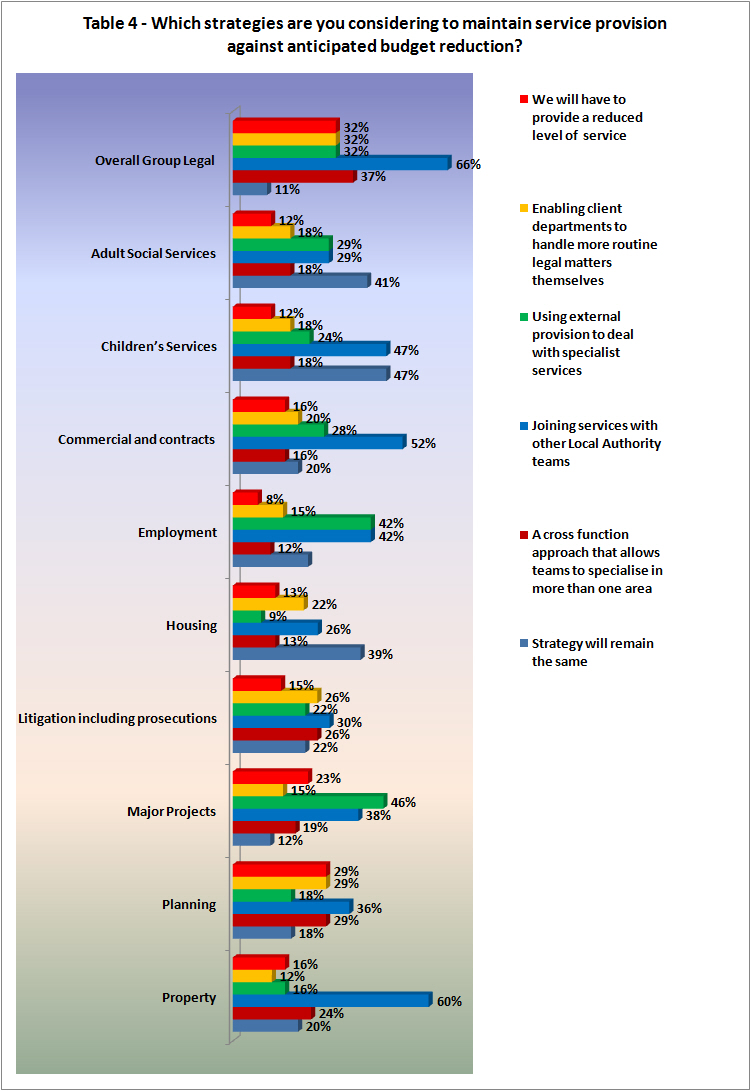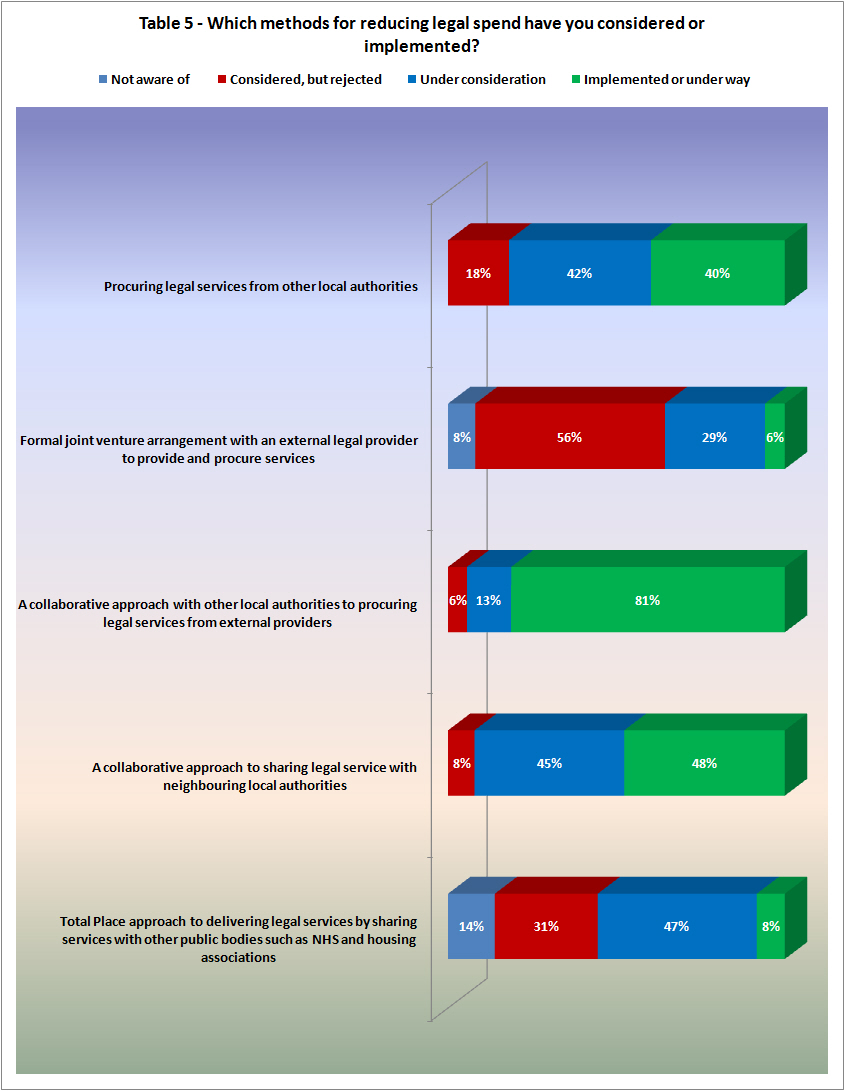Best foot forward
Local authority legal departments are facing some stark choices as the financial cuts bite. And there is a growing realisation that the old ways of delivering the service are no longer fit for purpose. Philip Hoult analyses the impact of the cuts and the strategies legal teams are adopting to cope with this unprecedented challenge.
When Manchester City Council announced severe cutbacks earlier this month including the loss of 2,000 posts, it appeared as though its legal team had survived relatively unscathed.
A report on the authority’s budget proposals, prepared for a meeting of its Executive, said there was “good evidence that our Legal Service is more cost effective than external provision and externalising this service would, therefore, only increase costs”. It went on to say that £50,000 in efficiency savings had been identified and that the service would work with directorates to consider opportunities for further savings.
The vast majority of legal departments elsewhere in England and Wales have not been so fortunate, a survey of heads of legal by Local Government Lawyer conducted in association with DMH Stallard reveals.
Whilst there may be a lucky few (13%) whose overall group legal budget has stayed the same (see Table 1), the vast majority are facing substantial cuts – two-thirds of respondents face a reduction of more than 10%, while one in five are dealing with a reduction of 20-30%. One respondent reported being required to at least model a 40% cut to see what kind of service could be delivered on that basis.
Drilling down into the budgets of individual practice areas, none are being left untouched – even children’s services. The percentage of respondents predicting a cut to each practice area budget were as follows: adult social services (44%); children’s services (45%); commercial and contracts (74%); employment (57%); housing (85%); litigation including prosecutions (76%); major projects (79%); property (73%); and planning (74%).
Squaring the circle
So what, some might say – the lawyers should only be expected to share the pain being felt across their authorities. Such ‘salami-slicing’ may seem a fair approach to adopt on the surface, but how do you square these diminishing budgets with the rise in demand for legal advice expected by heads of legal over the next 12-18 months?
Two-thirds (62%) of respondents say they are facing increased demand, while fewer than one in ten (8%) say the burden is falling (see Table 2). “I can only see client demand increasing with absolutely no regard whatever to available resource,” comments one respondent ruefully. Another adds: “We are still very busy and certain areas of our service have already experienced a 30%-plus increase in demand in the past 12 months so we have been doing more with less for some time already.”
This extra demand is being felt not just in one or two areas but pretty much across the board. Employment law is a particular pressure point, with nine out of ten heads of legal predicting extra demand. This is perhaps no surprise given the major reorganisations, job cuts and changes to terms and conditions that most local authorities have been seeking to implement, but also reflects in a number of cases the ongoing headache that is equal pay.
Jenny Thorp, Head of Public Sector and Employment Partner at DMH Stallard says: “We have been advising on radical changes at various authorities, not only to staff numbers, but to changes in terms and conditions including terms as to pay, allowances and benefits. We have also seen an appetite for the introduction of competency schemes linked to pay which have, until now, been almost unheard of in local government. There is inevitably more outsourcing and an increase in discussions around shared services and establishing trading companies, all of which have significant employment implications and which require clear legal advice from the outset.”
Significantly, the next two areas where additional demand is being felt most widely are adult social services (79%) and children’s services (68%) – pressures which show no sign of falling away. Not one local authority is predicting a reduction in demand for legal advice in children’s services, yet, as we have already seen, nearly half of departments say they will have to spend less in this area.
 When heads of legal were asked to identify the three areas where they think they will be most under pressure to deliver services (see Table 3), given reduced budgets and growing demand, employment received the most mentions (76%), followed by children’s services (45%), commercial and contracts (39%) and litigation and prosecutions, adult social services, and major projects (all 26%).
When heads of legal were asked to identify the three areas where they think they will be most under pressure to deliver services (see Table 3), given reduced budgets and growing demand, employment received the most mentions (76%), followed by children’s services (45%), commercial and contracts (39%) and litigation and prosecutions, adult social services, and major projects (all 26%).
Children’s services was ranked most frequently as the number one under pressure practice area, as the fallout of the Baby Peter case continues to be felt more than three years on. There is no sign of a let-up either, with Cafcass recently reporting the highest ever number of care applications for a January (at 677). The agency also said that between April 2010 and January 2011 it received 7,417 applications, 2.6% up on the same period the year before.
On the flipside, the survey shows that for some practice areas there are more respondents who predict a reduction in demand than respondents who predict an increase – notably in major projects, property and planning. This no doubt reflects in part the calling to a halt of various of the previous government’s most high-profile schemes, such as Building Schools for the Future. The BSF programme is now dead in the water, despite a recent High Court ruling which found that the Education Secretary had acted unlawfully by failing to consult adequately and discharge his equality duties. It will nevertheless be interesting to see whether these predictions turn out to be true. The government’s reforms to planning are radical and could throw up sizeable challenges, while many authorities are taking a long, hard look at their property portfolios and how these might be rationalised.
Similarly, it is hard to foresee the impact of flagship coalition government initiatives such as the Community Right to Build, which is intended to give groups of local people the power to deliver development, the Community Right to Buy, which will allow groups to bid for buildings on a “most wanted” list, and the Community Right to Reclaim, under which members can request the sale of unused public sector land and buildings.
So what do these findings mean in practice for legal departments?
“Pretty much all of us are going to have to do more with less,” suggests Susan Tovey, Head of Legal Services and Monitoring Officer at Test Valley Borough Council and current President of the Association of Council Secretaries and Solicitors (ACSeS). However, she questions how much leaner legal departments can become before the quality of service is adversely affected. “The problem is that people have been having to make cuts even before the current round,” Tovey says. “But only in odd areas – such as conveyancing – have I seen any reduction in work levels. And it is the difficult, more complex work as well which is increasing or staying the same.”
The ACSeS President also warns that many of the changes being introduced through the Localism Bill will subsequently require a significant degree of legal input. “That’s not the straightforward legal input, that’s not the day-to-day transactional legal work either,” she argues.
The twin challenge of rising demand and decreasing resource is going to be painful, particularly for smaller, second-tier authorities, warns Geoff Wild, director of law and governance at Kent County Council. He argues that it leaves “the illogical and seemingly unjustifiable and unsustainable situation” of local authorities having to either:
- Not do the legal work and thereby expose themselves to considerable legal, financial and reputation risk, or
- Put the legal work out at considerably greater cost than if it were done in-house, thus defeating the supposed object of reducing resources to save money, or
- Expect the legal work to be undertaken by a depleted, demoralised and already over-stretched in-house team, giving rise to the risk of mistakes and delays occurring, staff leaving and the like.
Finding a way through
 The research shows that, presented with this conundrum, the vast majority of heads of legal have concluded that simply charting the same course as before will not be enough. Just 11% report that their strategy will remain the same.
The research shows that, presented with this conundrum, the vast majority of heads of legal have concluded that simply charting the same course as before will not be enough. Just 11% report that their strategy will remain the same.
Two-thirds (66%) say they are considering joining services with other local authority legal teams, which will come as no surprise to anyone who has followed the news pages of Local Government Lawyer in recent weeks and months. Completed or potential tie-ups we have covered include:
- Talks between Manchester City Council and Salford City Council that could lead to the first shared legal service with more than 100 lawyers
- Southampton City Council and Fareham Borough Council
- Cannock Chase District Council and Stafford Borough Council
- The London Boroughs of Haringey and Waltham Forest
- The London Boroughs of Richmond and Merton
- Norfolk Public Law, which involves Norfolk County Council, Norwich City Council and Great Yarmouth Borough Council
- A group of authorities in South West Wales, including Carmarthenshire County Council and Bridgend County Borough Council
- Four district councils in Leicestershire and Warwickshire
- Cambridgeshire and Northamptonshire county councils.
Tovey says a key driver for legal teams at district councils and smaller unitaries is resilience. “We will often have one person who does contracts, one who does prosecutions and one person who does planning,” she points out. “You realise that you are heavily reliant on staff remaining fit and healthy. At a district level some kind of joint working can be attractive to deal with that challenge.”
This lengthy list of deals being done or contemplated belies the reality that some very different models are being put in place, ranging from a fully shared service along the lines of Lincolnshire Legal, which has been running for more than three years, to more ‘virtual’ operations.
Kent’s Wild urges legal departments going down the shared services route to be brave. “Unfortunately, attempts so far at collaboration have not been hugely successful, with few of the anticipated benefits or savings materialising,” he claims. “Those who have attempted some form of collaboration, have invariably done so warily. There is also a lack of willingness to ‘burn bridges’ and commit to going the whole way with reduced management, shared overheads and joint operating.”
 Until there is acceptance that a large degree of autonomy and sovereignty will have to be given up, Wild claims, then “any so-called collaboration is almost certain to add costs and delay rather than reduce them”. Quality and efficiency will suffer as a consequence, he argues.
Until there is acceptance that a large degree of autonomy and sovereignty will have to be given up, Wild claims, then “any so-called collaboration is almost certain to add costs and delay rather than reduce them”. Quality and efficiency will suffer as a consequence, he argues.
ACSeS’ Tovey agrees that rationalising senior management could be a way of making genuine savings. “The chances are that the junior lawyers who are doing the bulk of the work will be working flat out anyway,” she points out. “It might be that you could have one head of legal instead of two, so you’ll save half a salary.”
Some heads of legal, such as David Shepperd at Plymouth City Council, believe instead that significant results can be achieved without necessarily going down the route of a formal shared service. “What we were worried about was that lots of people around the country have spent lots of time looking at complicated joint venture and trading operations,” he says. “What we have done is put our efforts into working together collaboratively to deliver savings, and that’s coming to fruition.”
The Devon Solicitors Group of authorities has saved around £100,000 through its procurement of an electronic library service. “That’s not to be sneezed at,” he says. “We’ve also introduced a programme of shared training and persuaded some major firms to come to Devon to deliver it. These are two practical examples that every authority could do, and where the savings can easily be captured.”
The group is also developing what it refers to as centres of excellence, building on the particular strengths of particular authorities. “When it comes to highways law, Devon has a crack team,” Shepperd points out. “Plymouth has inner city problems so anti-social behaviour is something we do well. When we have staff resource issues, instead of picking up the phone to get a locum or private sector firm in, the first point of contact is the Devon Solicitors Group. Sometimes the work will be done free of cost, on other occasions at cost.”
The key message, Shepperd adds, is that there are simple things that all authorities ought to be doing to reduce their costs. Jenny Thorp of DMH Stallard believes that in-house teams should identify what they do best and then really focus on those areas, working with other authorities to close any gaps that there might be and providing services to each other. “This practice is already in place in many authorities that we work with, but more could be done”.
The second most widely considered strategy is to develop a cross function approach that allows legal teams to specialise in more than one area. Apparently reversing the trend for greater specialisation that has been seen – at least in the larger legal departments – in recent years, this would suggest that teams are trying to cover more of the waterfront than before in a bid to reduce their need to instruct external lawyers.
But such an approach brings its own challenges. For example, will there be a training budget that allows team members to develop their know-how? Will the lawyers feel too far outside their comfort zone? And will it heighten the risk of things going wrong? DMH Stallard's Jenny Thorp says that she has seen an increased demand for training for the in-house team so that they start to handle some of things that they might not have previously handled. “We have been working closely with some of our clients to help them in this process.”
Other popular strategies – considered by a third of heads of legal – include using external provision to deal with specialist services and enabling client departments to handle more routine legal matters themselves. The latter strategy makes eminent sense, particularly where heads of legal consider their team’s role to be preventative as much as curative. Time allocated to putting in place arrangements that mean client departments handle lower risk legal work and are less likely to get basic things wrong is likely to be well spent.
Planning and litigation (including prosecutions) are seen by respondents as two areas where this approach could work best. This strategy can, however, be difficult to implement in practice in those cases where both sides are more involved in fire fighting than forward thinking. It also throws up the question of resources for training.
Arguably the most worrying finding in the survey is the admission by almost a third of heads of legal (32%) that their anticipated budget reduction will mean that they may have to provide a reduced level of service. This could have significant implications in terms of risk management, particularly if it means people think “let’s not trouble the legal team with this issue as they’re always so busy”.
As one chief executive recently said, it is time to become less risk averse. Unfortunately, it is likely that this will lead to increased litigation, particularly where difficult decisions are made without proper and careful consideration.
“As can be seen from the recent decisions in the BSF and London Councils cases, it is critical that authorities don’t lose sight of their equality duties, which are changing with effect from April 2011," says Jenny Thorp. "If decisions are being taken without clear public consultation and engagement, they are more likely to be the subject of challenge.”
Keeping a close eye on legal spend
In this financial climate, the pressure to reduce legal spend is intense. The survey therefore looked at five different methods that heads of legal have been employing to cut their expenditure.
The strategy of collaborating with other local councils on procurement of external providers is the most widely implemented, adopted by 81% of authorities. Panels of law firms of course have been an established feature of the market over the last few years and continue to have a high profile. Recent examples covered by Local Government Lawyer include Cornwall Council, ACSeS Southern Branch, The North West Legal Consortium and EM Lawshare.
 A number of authorities have also started to look closely at their spend on barristers and put the disciplines of panels to work in this area as well. The London Boroughs of Southwark and Lambeth are in the middle of a procurement exercise aimed at establishing a £10m, four-year framework agreement with the promise of “significant reductions”. Authorities in the East of England have meanwhile taken a slightly different tack, proposing to create a database of practice and fee information for counsel.
A number of authorities have also started to look closely at their spend on barristers and put the disciplines of panels to work in this area as well. The London Boroughs of Southwark and Lambeth are in the middle of a procurement exercise aimed at establishing a £10m, four-year framework agreement with the promise of “significant reductions”. Authorities in the East of England have meanwhile taken a slightly different tack, proposing to create a database of practice and fee information for counsel.
The research suggests that this kind of collaborative procurement works – one in five respondents (22%) say it has provided significant savings, while 44% have seen some savings. The remaining third report that it is too early to say.
A dilemma for some authorities, however, is that they may be part of a framework agreement that was put in place a while ago and the rates quoted then were higher than might be the case if the tender was run now. There is also the issue that many quality firms will have seen their private sector work bounce back, so why would they agree to take on what they increasingly consider to be relatively unprofitable work?
Sharing legal services is a much more recent phenomenon and some 91% of heads of legal say they are considering or are implementing some form of collaborative approach with neighbouring local authorities (which may or may not involve formally joining up). Although a majority report it is too early to say how successful the arrangement will be, some 46% suggest it has already provided an efficient way of reducing spend.
But such a restructuring – particularly the more ambitious arrangement – has plenty of risks attached. Will it really deliver immediate savings given the front-loaded nature of the cuts? Will it lower morale within the teams involved, and heighten anxiety at a time of widespread job losses?
A Total Place approach to delivering legal services has also been much talked about. Almost half of heads of legal say the strategy is under consideration, while 8% report it is under way or has been implemented. However, if shared services between local authorities are seen as challenging, a Total Place arrangement is viewed by many as fraught with difficulty – “Total Place – don’t make me laugh” was one respondent’s terse comment.
Significantly, almost a third of respondents say they have considered such an approach only to reject it as unviable. This may be premature, given that a quarter of those to have implemented it say it has delivered savings (the other three-quarters report it is too early to day).
A fourth method of reducing legal spend is to establish a formal joint venture arrangement with an external legal provider. This is something that more than half have considered and later rejected, but again this could be precipitate. One in five respondents (22%) say this approach has delivered savings, while 11% say they have not really seen any benefit. The rest report that it is too early to say.
The fifth and final method, procuring legal services from other local authorities, is more popular. Its attractions are that local authority lawyers are cheaper than private practice, it can be relatively simple to construct and administer and – particularly for smaller teams at district councils – the arrangement can provide greater resilience.
But if the picture painted of reducing budgets and growing demand is accurate, what capacity will departments have to meet their own clients’ requirements, let alone others in another authority? Few local authority legal departments are fully geared up to meet the needs of their own authority during peak times, let alone those of others on anymore than an ad hoc basis.
All five methods of reducing spend have their challenges. This begs the question whether there is scope for legal teams to do more to generate revenues, extract value and ensure authorities receive their due – an approach we consider in the second article in this report.
It could be tempting in the current climate to be unremittingly gloomy, but there are arguably some positives to be taken. One is the recognition that ideas that previously might have been talked about for ages without much headway being made, are now leading to action. For the proactive local authority head of legal and their teams, now may prove to be a time of opportunity as well as risk.
Philip Hoult is Editor of Local Government Lawyer. He can be contacted on 020 7239 4915 or by email at This email address is being protected from spambots. You need JavaScript enabled to view it..
For more information on how to implement revenue-generating strategies or deliver shared services models, contact Jenny Thorp, Head of the Public Sector group at DMH Stallard, on 01293 605061 or by email at This email address is being protected from spambots. You need JavaScript enabled to view it..
Demographics: Local Government Lawyer surveyed 50 heads of legal at local authorities in December 2010.





